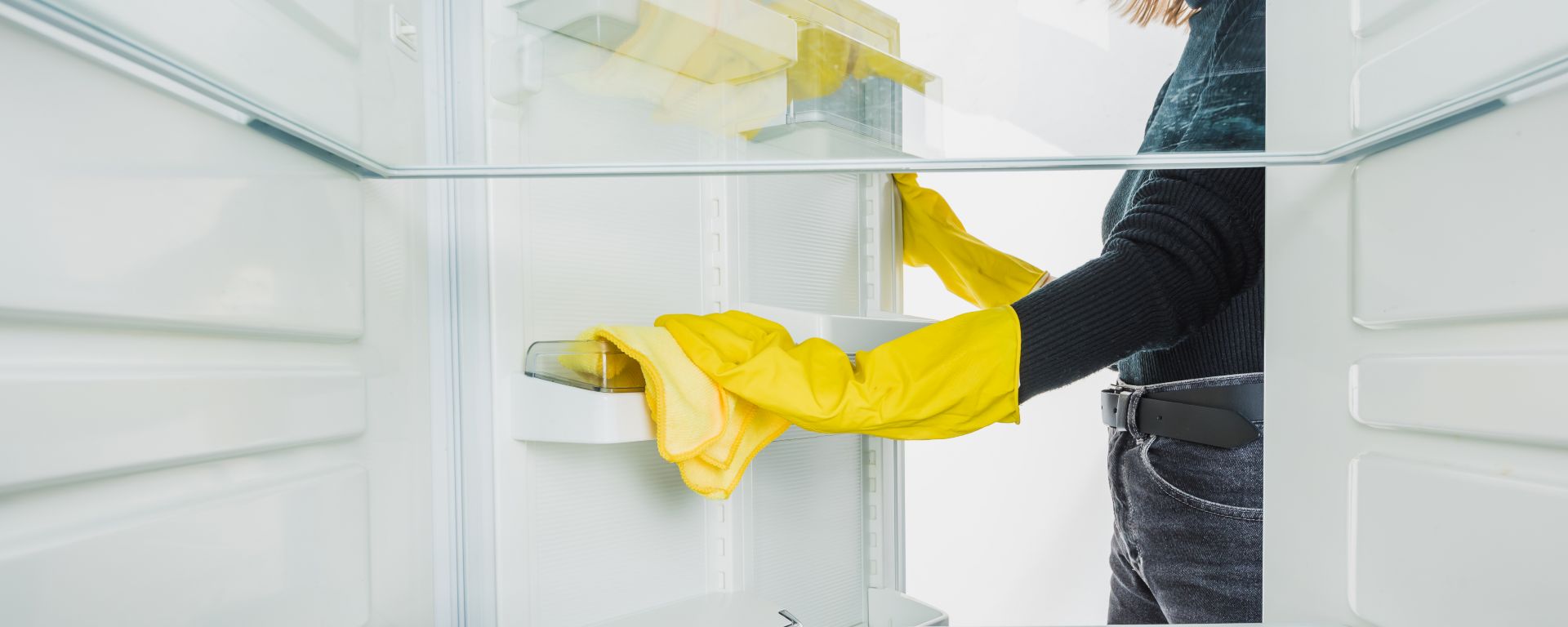Cleaning a fridge is one of those tasks we love to avoid. When the fridge is clean on the outside it’s easy to forget the inside probably doesn’t look as fresh after some time. You may have just noticed that your fridge needs to be cleaned of condiments and jam jars sticking to the glass, or that there’s a strange odour coming from it. These are two tale-tell signs that your fridge needs some care. A clean fridge goes hand in hand with having a clean kitchen. Clean your fridge when you spring cleaning your kitchen, or at least try to get into the habit of cleaning your fridge more regularly. No one wants to eat food from a grimey environment. A clean fridge also ensures that your family’s food and drink are safe. It doesn’t have to take a whole day to be done; follow these cleaning hacks to help you out.
You Will Need:
- A cooler bag
- Ice packs
- Baking soda
- White vinegar
- A microfiber cloth
- A basting tool
- A bottle brush
- Cotton buds
- Toothpicks
- A handheld vacuum
1. Empty Contents
Instead of emptying your entire fridge, it’s smarter to check the use-by dates of food items and throw away anything that’s expired, then wipe the underside of the sticky bottles and jars before putting them on the countertop. Remove meat and dairy products and place them in a cooler bag with ice packs, especially on a hot day, as bacteria will multiply faster at room temperature.
Try to time cleaning your fridge so that it isn’t packed with fresh groceries that you will have to take out again.
2. Remove the Shelves And Fittings
Unplug or switch off the fridge; the plastic should be at room temperature before you attempt to remove it. They are less likely to crack if they’re not so cold. Once you’ve safely removed the fridge shelves and drawers, soak them in warm soapy water.
3. Clean The Inside Of The Fridge
The best agent you can use to deodorise your fridge is white vinegar. With the drawers and shelves removed, spray the inside of the fridge with a cleaning mixture of white vinegar and water. Concentrate on areas with dried-on grime. After spraying the interior, leave it to soak for a while, while you work on the earlier removed drawers or shelves. Once some time has passed, go back to the fridge and wipe it thoroughly with a damp microfiber cloth. Remember to rinse and wring it out regularly. The water and vinegar should work like a charm at getting rid of sticky messes and bacteria, as well as horrible fridge smells. You should always clean from the top downwards so that any debris will automatically fall lower down to be cleaned.
Baking soda is an antibacterial, natural cleaning agent, great for many household cleaning tasks, and is just what you need for a stinky fridge. Simply create a paste from hot water and baking soda. Wipe the paste all over the fridge’s interior with a damp microfiber cloth before rinsing it with a clean cloth, and then drying with a paper towel. You should be sure to always allow the fridge to dry completely before placing the food items back in. For hardened, dried-on food, let the paste soak in for 10 minutes. Once softened, proceed to wipe it off.
4. Clean The Fridge’s Drain hole
Even if your fridge is fully functioning, it’s still ideal to include this step. You will need to use a drain hole brush which is similar to a miniature plumber’s snake. This is used to clean your fridge’s drain hole. Most of us are unaware that fridges have this. A fridge drain hole is usually found at the bottom back wall of the fridge; these are designed for condensation to filter through the hole into a small pan that sits on top of the compressor. The heat from the compressor causes water to evaporate. If this gets blocked it can cause problems for the rest of the fridge.
If there is something clogging up the hole, whatever it is will likely be a gross surprise. Use a basting tool to apply a small amount of vinegar and water into the drain hole. You should have removed as much mould and mildew as possible with the drain hole cleaning tool. Use a cotton bud to make sure the vinegar and water mixture is moved around the drain hole to remove any remaining residue.
Use the cleaning mixture to wipe the bottom of the fridge before returning the fruit and vegetable draw. Keep the drain cleaning tool somewhere safe, close by to the fridge. This is so that you can clean out the drain hole every few months to keep the fridge running efficiently.
5. Clean The Fridge Drawers
You must remove the fridge drawers completely to be able to clean them. Take out the drawers, empty them, then soak them in warm soapy water. Using a bottle brush, or even an old toothbrush. Rinse them out, dry them, and replace them in the fridge. If you’re worried about not putting things back in the right place, simply wash, dry and replace one drawer at a time.
6. Clean The Fridges Shelves
Remember to allow the shelves to reach room temperature before placing them in hot soapy water. If there are still hard-to-scrub-off bits between the shelf and its surface, you should use a toothpick by running it along the joins in the shelf and then follow through by wiping away whatever is scraped off.
A cotton bud or old toothbrush is handy for getting dried-up bits of food out of groves in the interior.
If you want to avoid using soapy water to clean the shelves and drawers of your fridge, rather use baking soda in warm water. Something you shouldn’t do is put your fridge’s fittings into a dishwasher; the water will be too hot, especially for plastic.
7. Clean The Fridge’s Seals
Crumbs and spills can build up quickly on the fridge door seals or gasket. It’s a good idea to make use of your handheld vacuum or clean them with a stiff old toothbrush or scrubbing brush. For accumulated gunk, wrap a microfiber cloth around a blunt knife, dip it in a vinegar and water solution, and gently run it along the crevices of the seals. This should ensure that crevices are clean and hygienic before closing the door.
8. Clean The Freezer Compartment
If you have made it to this point, you may as well go ahead and learn how to clean a freezer if your fridge has one built into it. Firstly, place a dry towel on the floor just under the freezer to catch any ice chunks or water that will spill out when defrosting it.
When defrosting your freezer, it should be switched off and emptied. Keep food in a freezer bag to keep it cold and fresh. Again, the shelves or trays should be at room temperature before placing them into warm water to prevent cracking. Leave the freezer door open for a few minutes to let the ice melt, then use a freezer defroster ice shovel to remove the biggest bits of ice. Watch out for the freezer’s lining.
Fill and empty the spray bottle with equal parts warm water and white vinegar, then spray the freezer walls. With a microfiber cloth, wipe the cleaning mixture into the surfaces, and make sure to dry thoroughly.
The best way to help your freezer function is to not overload it; you should store food evenly so that air can properly circulate. Be sure that food is always properly covered or kept in an airtight container when it goes into the freezer. Wipe up ice tray spills for the freezer to be free of ice.
9. Let the fridge and freezer cool before restocking
Once the fridge has been washed and dried thoroughly, you can close the door, plug the fridge back in, and switch the temperature regulator back on if necessary. Wait for the fridge to reach 4°C or less before placing your food items back into the refrigerator, and the freezer back to -18°C before placing the food back inside. At this stage, you should keep in mind that foods which may not be used by their expiry date should be placed in the freezer. There should be clear labelling stating whether you can freeze the food or not.
Keep leftovers in small plastic containers, label them, and include the date before placing them in the fridge or freezer. It’s best to go for a BPA-free container.
10. Clean The Exterior Of Your Fridge
For the white exterior of your refrigerator, you can use baking soda or soapy water just like the interior. Simply dampen a clean cloth, pour some baking soda and you’re ready to clean. Remember to wipe the top of the fridge too as they can become sticky and dusty, and make sure to pay attention to the handles and the areas around. They become dirty quite quickly from constant contact.
Additionally, handles can often harbour more germs than your toilets. If you have a chrome or stainless steel refrigerator, take the time to read through how to clean stainless steel. This is because stainless steel fridges require working with the grain, preventing water spots and finishing with oil.
If you still have the vinegar cleaning solution left, use it for the exterior of your fridge. The acid will break down bacteria and keep the fridge free from fingerprints while adding a shine. Anti-bacterial wipes also work well, you may want to keep some packets on hand.
How Often Should You Clean The Fridge
You should clean your fridge regularly, at least once a week. Remember to clean your fridge a day or so before dustbin day and before you buy the groceries for the week.
How To Clean A Smelly Fridge
Your fridge will only stink if the food has gone off; check to see if your fridge is at the correct temperature. Your fridge should be set at 4°C or less and the freezer at -18°C. If the temperature isn’t an issue, then you’ll need to clean the entire fridge with the steps above, including the drainage channel. If you don’t have vinegar or baking soda at the ready, here are some other methods you can use to clean your fridge:
- Coffee: Spread ground coffee on a tray and leave it in the fridge; the ground coffee will soak up bad smells after a few days. You can use coffee grounds to freshen up your kitchen bin as well. This method can be done with activated charcoal and porridge oats too. Leave the tray for a couple of days, then throw it away.
- Vanilla-soaked cotton wool: If you want your fridge to smell like freshly baked cookies, soak a few cotton balls in vanilla extract and place them inside the fridge.
- For a citrus scent in your fridge, cut a lemon in half and place it face down in your refrigerator. You can use orange peels in the same way if you don’t want to waste lemons.
- Airtight containers are best to keep the taste of food fresh and any smells contained.
Where Does The Water At The Bottom of The Fridge Come From
The water at the bottom of the fridge results from condensation that naturally accumulates in a fridge. It should be collected in the drain hole at the back of the fridge where it goes into an evaporation pan and should evaporate. However, a blocked drain hole is caused by bits of food that get stuck there, which causes condensation to collect as pools of water at the bottom of the fridge or even inside your vegetable drawer. If there is water gathering at the bottom of your fridge, check for noticeable blockages. If you’re not able to see anything, you will have to clean the fridge’s drain hole as stated above.
What To Do With Your Fridge If Going On Holiday
The best thing to do if you’re going away for the holidays, is to remove any food items that you think may go off, and freeze them. Better yet, if like most of us, your home is prone to load shedding, you should try to eat up everything in your fridge before you leave, or simply give it away to friends and family, or the less fortunate.
If you know that you’re going away for more than a couple of weeks, then you should empty your fridge, unplug it so that it stays off, and leave the door open. Organise your grocery shopping so that when you come back from your travels, it won’t be long before there are fresh foods in your fridge.
Deodorise Your Fridge Between Cleans
The smell of your fridge relies solely on the types of food kept in it, even a regularly cleaned fridge can still have a slight smell. Strong smelling foods like cheese, garlic, and other sorts of pungent foods, are usually responsible for nasty smells in the fridge, despite the condition of the food.
To prevent your fridge from stinking, storing food in airtight containers is the best way to go. Another option is placing a cup filled with baking soda inside the fridge. For larger fridges, you may need to place a cup on every shelf. Baking soda prevents strong smells from staying inside the fridge by absorbing the smell.
Tips On Keeping Your Fridge Clean
Here are a few tips for keeping your fridge clean. Don’t forget to dry everything thoroughly, you don’t want there to be any moisture left in your fridge after cleaning.
- For a quick clean, you may want to fill the vegetable drawer with warm soapy water and then use this to wipe the interior of the fridge, while soaking the shelves and liners in the sink.
- Avoid spills from happening by organising and assigning certain food specific areas. Even if you’re as careful as possible, food can drip out or spill down the sides of a container, leaving a sticky stain on your refrigerator. Organising your fridge into ‘food zones’ is a smarter way to prevent spills.
- Make use of labels for the shelves so everyone at home knows where items go in the fridge. Take note of the height of your food items so they can be grouped together, and change the shelf heights if needed.
- Another idea you may want to implement is using plastic bins or baskets to organise food items into groups, so when making food you can easily take out the basket and everything you need at the ready. This is better than having to make numerous trips to the fridge. Bins also catch spills and it’s easier to clean the inside of them instead of the whole fridge should you have an accident.
Now that you know how to clean out your fridge, try not to delay any further. Regularly cleaning your fridge will help it to keep on running properly for your stored foods, and keep them fresh and safe to eat. Cleaning your fridge will help to prevent stains and smells from building up in your fridge, and help your fridge last longer. For cleaning other appliances and areas of your home, our blog has several useful cleaning how to’s and guides.








